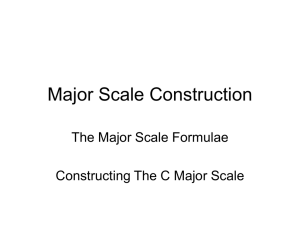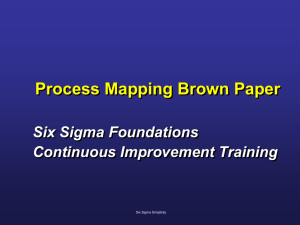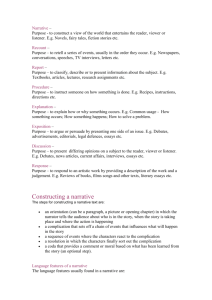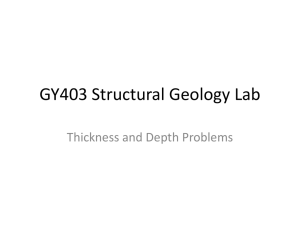Constructing a cross section - School of Earth and Environment
advertisement
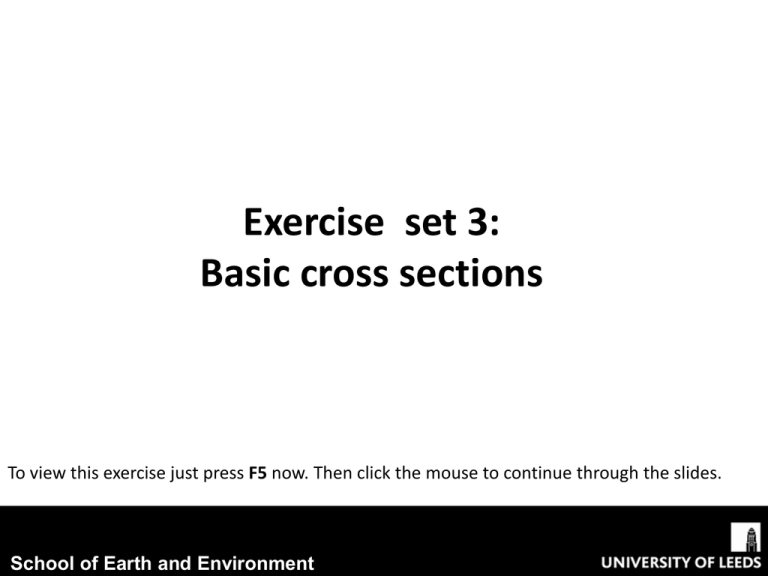
Exercise set 3: Basic cross sections To view this exercise just press F5 now. Then click the mouse to continue through the slides. School of Earth and Environment Introduction to cross sections • This presentation is to be completed in conjunction with exercise worksheet 3. Objectives: • By the end of this exercise you should: • Understand the importance of cross sections. • Be able to construct cross sections from basic geological maps. • Be able to calculate true thickness of beds. School of Earth and Environment Introduction to cross sections • A key goal of structural geologists is to understand the three dimensional geometry of rocks. • Unfortunately all that can be directly observed are rocks at the Earth’s surface or, in special cases, one dimensional information obtained from well logs. • The shape of the structures below the surface and the projection of those features into the air (before they were eroded) must be inferred. • Cross sections are 2-D educated guesses at the geology along a plane different from the Earth’s surface. • Although this plane is almost always vertical, there are instances where it is desirable to project geologic structures into a dipping plane. •As is true of many problems in geology, there are often numerous possible interpretations of the same data. •The best we can do in drawing a cross section is to come up with an interpretation that is consistent with all the available data. School of Earth and Environment Calculating true thickness of a bed • Calculating true thickness from a map is actually very simple, just plug all the necessary numbers into the following equation: True thickness (t) = width of outcrop (w) x sin (θ) (angle of dip) • Example: If the width of an outcrop is 100m and has a dip of 14o then t = 100m x sin(14) t = 24.2 m School of Earth and Environment Constructing a cross section: Example Here is our original map. Fill in the example on exercise sheet 3 as we run through it. Step 1 : •First determine the line along which you are going to draw the section, it should: • Be representative of the study area. • Cross all major structural features (e.g. faults and folds) • have appropriate data on the map or well logs to draw a complete section. • Often be drawn perpendicular to major structural features. School of Earth and Environment Constructing a cross section: Example Step 2: •Now on some graph paper draw an x axis with the same scale and length as the line of the cross section. • Then add y axes to both ends, that have a relevant scale to the topographic contours. • So that it looks something like this: School of Earth and Environment Constructing a cross section: Example Step 3 : • Using a scrap piece of paper, mark on where structure contours intercept your cross sectional line. School of Earth and Environment Constructing a cross section: Example Step 4 : • Now, overlay your scrap piece of paper with your cross section and mark on the different topographical contour points. School of Earth and Environment Constructing a cross section: Example Step 5 : • If you join these dots up, you should end up with an accurate scaled topographic cross section that looks something like the one below. School of Earth and Environment Constructing a cross section: Example Step 6 : • Now, with your scrap piece of paper add in where the lithological boundaries intercept your cross sectional line School of Earth and Environment Constructing a cross section: Example Step 7 : • Now, overlay your scrap piece of paper with your cross section and mark on the different lithological boundaries. School of Earth and Environment Constructing a cross section: Example Step 8 : • Now, extrapolate from these points the bed boundaries; If they dip, then draw the lines at the correct angle of dip for each bed. • However for this example, as the unit boundaries followed the contours, they are evidently horizontal (remember The Law of “V’s”) • Now you have drawn an accurate, to scale, cross section. School of Earth and Environment Constructing a cross section: Problem • Now have a go at the next problem by yourself, by answering the questions on the graph paper provided on exercise sheet 3. • Then check your answers on the following slides. Questions Geological outcrops are shown in the NW corner of the map. 1. Complete the geological outcrops over the whole map. 2. Draw a vertical columns showing each of the beds in stratigraphic order and to scale (use a scale of 1cm = 100m). Indicate the actual thickness of each bed. 3. Draw a section along the line A-B. School of Earth and Environment Constructing a cross section: Problem Answer to question 1: School of Earth and Environment Constructing a cross section: Problem Answer to question 2: • Often a jagged line is drawn at the bottom of a stratigraphic column where the thickness of a unit is unknown. • As these beds are horizontal the actual thickness is the same as the outcrop width. School of Earth and Environment Constructing a cross section: Problem Answer to question 3: School of Earth and Environment Summary We have now worked through: • Some of the reasons why cross sections are important. • How to construct a simple cross section from basic geological maps. • How to calculate the true thickness of beds. School of Earth and Environment

